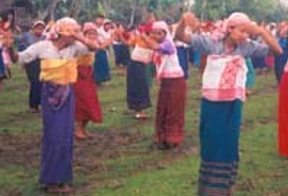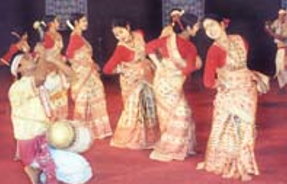|
Bihu Dance Assam |
|
The Bihu Dance is one of the most colourful folk dances of India. Bihu is generic to celebration in an agricultural society. For the people of Assam, Bihu is not only a festival, but also a time for celebration. The Assamese people celebrate three different Bihu festivals, Bohag Bihu or Rangoli Bihu, celebrated in Spring, Magh Bihu or Bhogali Bihu celebrated in Winter and Kongali Bihu or Kati Bihu celebrated in Autumn. The Bihu dance is a traditional heritage of Assam and the festival helps to strengthen the unity in diversity among the people of Assam. During the revelry, the banks of the Brahmaputra come alive with the rhythms of the Dhol (drum) and pepa (flute). The dancers perform in a circle beginning with a slower tempo, which gradually gains momentum. Drums, cymbals, hornpipes, harps and bamboo clappers, provide musical accompaniment. Though the dance is inspired by agricultural operations, the songs and the graceful dancing builds up an atmosphere of love and romance. The dance has been noted for maintaining authenticity and at the same time displaying the traditional Assamese handlooms and handicrafts in their beauty and glory. The costume worn by the women consists of a Gitigee (kind of headgear), Agoo (mekhala) and Lagu Richa (chaddar). Beautiful ornaments are their accessories. The men wear a Dhoti, Gomocha (Towel) and Chapkan (shirt). The well-known forms of the Bihu Dance include
. |
|
Bohag Bihu or Rangoli Bihu.
|
|
With the advent of spring come the Bohag Bihu or Rangoli Bihu, a festival of music and dance when nature like a young woman blossoms into radiance of light, beauty and colour. It is in this atmosphere that young boys and girls perform the Bihu Dance, inviting each other to the land of romance. The Bohag Bihu or Rangoli Bihu not only ushers in the Assamese New Year, but also the sowing time and the season of marriage. In fact, this festival has its roots in some earlier fertility cult. The Bohag Bihu Dance is an expression of the joys of spring and the exuberance and vigour of youth. Amidst nature's pristine beauty, young boys and girls perform this dance, accompanied by songs of erotic sentiment, virile beating of drums (dhol), soft strains of Pepa made from buffalo horns and many other indigenous folk instruments.
|
| Magh or Bhogali Bihu |
|
The Magh or Bhogali Bihu is also an important festival celebrated after the harvest is collected. Bonfires, social get togethers and feasts are an integral part of Magh Bihu. Most of the rituals connected with this season's Bihu are observed in front of Agni, the God of Fire. Various offerings are made to Agni with the chanting of mantras. The origins of Magh Bihu can be traced back to the Fire-Worship Festival of ancient times. The Bhogali Bihu Festival begins on the last day of the month of Pous and the actual day of celebration is the first day of the month of Magh. |
| Kaati Bihu or Kongali Bihu |
|
This Bihu festival is not celebrated with the usual pomp with which the other Bihu festivals are celebrated. The day of celebration is the last day of the month of Ashwin when the new crops are not ready for harvesting and the previous harvest stored in the granary has been depleted. The festival reminds people of the scarcity of food. It is a time to offer prayers for a good harvest in the coming season. Prayers are possibly the most significant part of this festival. Differences exist in the presentation of the Bihu Dance, depending on the community presenting it. |
| Moran Bihu |
|
Moran Bihu is a typical form of Bihu Dance practiced by the Moran tribe of Assam. Generally, young Moran boys select a place far away from the din and bustle of the city. Here they make a wooden bamboo-house known as the Bihu-Ghar. The ghar is separated into two areas one for the young boys and the other for the girls. Their songs and dances are woven around the theme of love and yearning. Indigenous instruments such as the Dhol and pepa provide the musical accompaniment. |
| Deori Bihu |
|
The Deoris of Assam are a riverine tribe who originally belonged to the Lohit district of Arunachal Pradesh. They have preserved and maintained their traditions, religious beliefs and practices. The Deories celebrate the Bohag Bihu or Bhohagiyo Bihu and the Magh Bihu or Maghyo Bihu. The presentation of Bihu by this community has a distinct style. |
Mishing Bihu |
|
Mishing Bihu is a form of Bihu dance associated with the Ali-Ai Ligang festival (seed sowing festival) of the Mishings. The dance demonstrates the various stages of the process of cultivation from sowing to reaping. The Bihu songs of the Mishing tribes have a telltale note, a lovely eiiyoo oh that rises and falls, as if a cowherd is calling out to his beloved who is reaping the paddy. The Mishings have starkness in their Bihu that captures the spirit of the festival, of Spring, fertility, longing, of the beautiful kopon flower (the Assamese orchid) and love like no other. It is the time to sing about Jonki and Panoi, the Romeo and Juliet of the Mishings. |
| Jeng Bihu |
|
Jeng Bihu is an ancient form of Bihu Dance from Upper Assam. Only women perform this form of Bihu Dance on a moonlit night in a place far away from an inhabited area. The word Jeng possibly means an obstructive barrier between the performers and the audience. |
| Mukholi Bihu |
|
This dance is similar to the Rangoli Bihu. The young boys invite the girls with Bihu songs, the beating of drums and the tunes of the pepa to join them in the open fields. They exchange feelings of love and affection in the season of love, Spring. The buffalo horn pipes and bamboo clappers paint a portrait of Spring that is not seen anywhere else. It is a time when youngsters meet in the fields to dance, a time when young girls in love weave handkerchiefs for their chosen ones. |
| Bordoishikla dance Assam |
 |
|
The Bodos like the other communities of Assam have nurtured their own distinctive music and dance forms. They have contributed towards upholding the cultural traditions of Assam to a large measure. Bordoishikhla, a very special folk art form of the Bodo community, is one of the most colourful and rhythmic dances of Assam. Young girls assemble in a particular area of the village to perform the dance to relieve themselves of their wearisome days work through singing and dancing. It is also closely associated with harvesting and is performed to welcome a good Monsoon. The dancers perform with bamboo clappers in their hands, which provide the rhythm for their movements. The colourful costumes worn by the dancers and graceful body movements make the dance fascinating. This group dance is performed to the accompaniment of traditional musical instruments like Kham, Siphung, Jotha, Charinda and Cymbals. |

